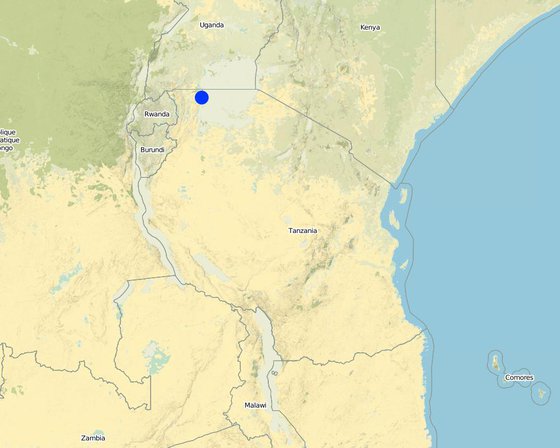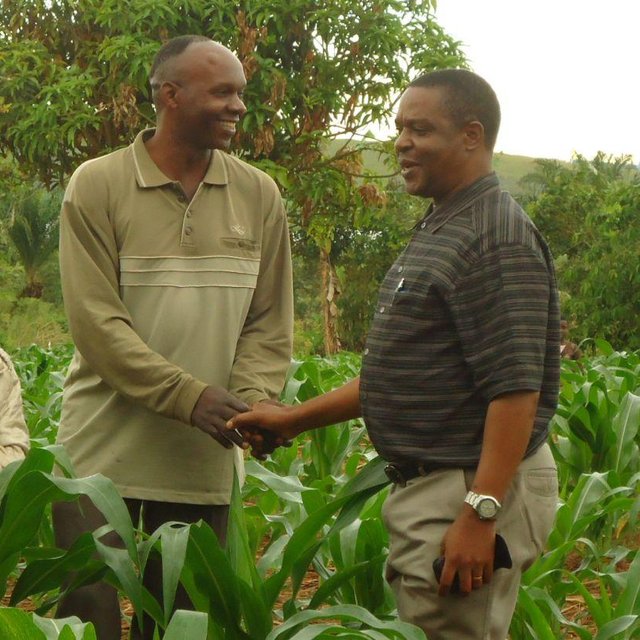

The spread of dry Hyperrhamia rufa 15cm thickness across the slope combined with manures, TSP and CAN in maize production technology is applied on annual cropland for reduced declining soil fertility, reduced soil erosion and improved soil moisture content in the sustainable land agro-ecosystem management. The activities to implement the technology includes to slush bushes and cut grasses using sickles , to cultivate the land using hand hoes, to measure spacing demarcate and dig holes using hand hoes, to mix manure, soils and TSP in a 5cm depth hole using hands, to spread grass mulch using hands, to plant maize seeds using hand hoes, to apply CAN at week four after planting using hands, to weed the whole field using hands, to apply a mixture of ashes and pepper on the tip, closed tip leaf to control maize stock-bores and to harvest and trush using hands
This technology is applied on annual cropland using agronomic measures in the sub humid climatic zone. The slope category of that land is gentle, characterized of loam sandy soil textures with medium soil depth.
The technology is applied by Individual / household, Small scale land users, common / average land users, men and women. The Land ownership is individual, not titled and Land use rights is individual as well. Water use rights is open access (unorganized).
The relative level of wealth categorized as, rich, which represents 20% of the land users and own 32% of the total area. Average, which represents 64% of the land users and own 64% of the total area. Poor, which represents 20% of the land users and own 4% of the total area.
The technology was introduced in 2012 by TAMP -Kagera using FFS in the community integrated catchment approach.
To implement the technology it was calculated to be US$ 57.059 for establishment and US$ 1,923.36 maintenance costs.
Purpose of the Technology: The major purpose of the technology is to prevent loss of top soil, to improve soil fertility decline and reduced organic matter content on the annual cropland with a sustainable land management to improve community livelihood.
Establishment / maintenance activities and inputs: This technology has no establishment activities as a common phenomena for all Agronomic measures. The maintenance activities of the technology includes; To slush bushes and cut grasses using sickles in Late August, To cultivate the land using hand hoes in Earl September, To measure spacing, demarcate and dig holes using hand hoes in earl September, To mix manure, soils and TSP in a 5cm deep hole using hands in mid september, To spread dry Hyperrhamia rufa using hands mid September, To plant maize seeds using hand hoes Late September, To apply CAN at week four after planting using hands in mid October, To weed the whole field twice using hands in early November and early February , To apply a mixture of ashes and pepper on the top openleaf to control maize stock-bores, To harvest and trash maize cobs using hands in Late February redy for marketing in late May.
To perform the maintenance activities the following inputs required; Labour, tools, seeds, fertilizer, biocides and compost/manure. All inputs can cost a total of US$ ...........0 per hector per season.
The dry Hyperrhamia rufa mulch in the Zea maize pure stand complemented withi cow dung, TSP and CAN introduce in April 2012 by TAMP -Kagera in the Butulage catchment.
Natural / human environment: This technology is applied on the cropland type in the subhumid. The landform of this catchment is plain and footslpoes with gentle slope. It is obvious that, the land is prone to sheath erosion, soil fertility decline and reduced organic matter content. However, the cause of these types of land degradation includes direct (human and natural) and indirect (land use supporting system). The technology is tolerant of seasonal rainfall decrease and drought or dry spell climatic extremes. On another hand the technology is sensitive to foods where excess water will lodge and damage the maize roots.
The land ownership is individual not titled and catergorised in small scale farmers who practiced mixed production mode. The wealth of the people applying this technology can be categorized as poor, average and rich according to land ownership. The poor repents 20% of land users and own 4% of the cropland area. The average category represents 64% of the land users and own 64% of the cropland area. The rich category represents 20% of cropland users and own 32% of the cropland.

ទីតាំង: Bukoba D.C, Tanzania, ប្រទេសតង់សានី
ចំនួនទីកន្លែងបច្ចេកទេស ដែលវិភាគ:
ការសាយភាយនៃបច្ចេកទេស: ត្រូវបានផ្សព្វផ្សាយត្រឹមតំបន់មួយ (approx. < 0.1 គម2 (10 ហិកតា))
តើស្ថិតក្នុងតំបន់ការពារអចិន្ត្រៃយ៍?:
កាលបរិច្ឆេទនៃការអនុវត្ត: តិចជាង 10ឆ្នាំមុន (ថ្មី)
ប្រភេទនៃការណែនាំឱ្យអនុវត្តន៍៖






| បញ្ជាក់ពីធាតុចូល | ឯកតា | បរិមាណ | ថ្លៃដើមក្នុងមួយឯកតា (Tshs) | ថ្លៃធាតុចូលសរុប (Tshs) | % នៃថ្លៃដើមដែលចំណាយដោយអ្នកប្រើប្រាស់ដី |
| សម្ភារៈ | |||||
| Handhoes | pieces | 16,0 | 2,94 | 47,04 | 100,0 |
| Machete | pieces | 16,0 | 1,17625 | 18,82 | 100,0 |
| Sickles | pieces | 16,0 | 0,47 | 7,52 | 100,0 |
| tape measures | pieces | 1,0 | 11,76 | 11,76 | |
| ថ្លៃដើមសរុបក្នុងការបង្កើតបច្ចេកទេស | 85.14 | ||||
| ថ្លៃដើមសរុបក្នុងការបង្កើតបច្ចេកទេសគិតជាដុល្លារ | 0.05 | ||||
| បញ្ជាក់ពីធាតុចូល | ឯកតា | បរិមាណ | ថ្លៃដើមក្នុងមួយឯកតា (Tshs) | ថ្លៃធាតុចូលសរុប (Tshs) | % នៃថ្លៃដើមដែលចំណាយដោយអ្នកប្រើប្រាស់ដី |
| កម្លាំងពលកម្ម | |||||
| Slush bushes and cut grasses using sickles | person/days | 20,0 | 1,7645 | 35,29 | 100,0 |
| Cultivate the land using hand hoes | person/days | 66,0 | 1,78 | 117,48 | |
| Measure spacing demarcate and dig holes using hand hoes | person/days | 4,0 | 1,7 | 6,8 | |
| Labour: Harvest and trush using hands | person/days | 225,0 | 1,7647 | 397,06 | |
| សម្ភារៈ | |||||
| Polythene bags | pieces | 10,0 | 0,588 | 5,88 | |
| សម្ភារៈដាំដុះ | |||||
| Grass mulch | bundles | 1500,0 | 0,29412 | 441,18 | |
| Seeds | kg | 25,0 | 2,9412 | 73,53 | |
| ជី និងសារធាតុពុល | |||||
| Fertilizer | kg | 185,0 | 0,97 | 179,45 | |
| Mixture of ashes and pepper | tons | 18,518 | 0,14688 | 2,72 | |
| Compost/manure | tons | 18,518 | 29,412 | 544,65 | |
| ផ្សេងៗ | |||||
| Labour: Mix manure, soils and TSP in a 5cm depth hole using hands. | person/days | 12,0 | 1,7 | 20,4 | |
| Labour: Spread grass mulch using hands. | person/days | 15,0 | 1,76 | 26,4 | |
| Labour: Plant maize seeds using hand hoes | person/days | 4,0 | 1,7 | 6,8 | |
| Labour: Apply CAN at week four after planting using hands. | person/days | 8,0 | 1,7 | 13,6 | |
| Labour: Weed the whole field using hands | person/days | 6,0 | 2,353 | 14,12 | |
| Labour: Apply a mixture of ashes and pepper on the tip closed tip leaf to control maize stock-bores. | person/days | 4,0 | 1,7 | 6,8 | |
| ថ្លៃដើមសរុបសម្រាប់ការថែទាំដំណាំតាមបច្ចេកទេស | 1'892.16 | ||||
| ថ្លៃដើមសរុបសម្រាប់ការថែទាំដំណាំតាមបច្ចេកទេសគិតជាដុល្លារ | 1.11 | ||||
គុណភាពមុន SLM: 1
គុណភាពក្រោយ SLM: 3
Maize yield increased from 1t to 3t per hectors.
គុណភាពមុន SLM: 0
គុណភាពក្រោយ SLM: 1
Formelly used as farrow or rangelands can be used for maize production.
គុណភាពមុន SLM: 1
គុណភាពក្រោយ SLM: 3
Mulch and manures costs
គុណភាពមុន SLM: 0
គុណភាពក្រោយ SLM: 1
Weeding once insted of twice but mulching demands more labour
គុណភាពមុន SLM: 0
គុណភាពក្រោយ SLM: 2
Maize is food, excess can be sold to earn money, money can be used to aquire animal protein source to utilise the balanced diet.
គុណភាពមុន SLM: 0
គុណភាពក្រោយ SLM: 1
Increased maize productivity should access market and the increased accrues empowers the household to meet financial obligations especially for health and education costs.
គុណភាពមុន SLM: 2
គុណភាពក្រោយ SLM: 1
grass mulch
គុណភាពមុន SLM: 0
គុណភាពក្រោយ SLM: 1
grass mulch
គុណភាពមុន SLM: 0
គុណភាពក្រោយ SLM: 1
grass mulch
គុណភាពមុន SLM: 1
គុណភាពក្រោយ SLM: 3
grass mulch
controlled rill erosion
គុណភាពមុន SLM: 1
គុណភាពក្រោយ SLM: 3
manure, TSP & CAN.
គុណភាពមុន SLM: 1
គុណភាពក្រោយ SLM: 3
manures
គុណភាពមុន SLM: 1
គុណភាពក្រោយ SLM: 2
trashlines